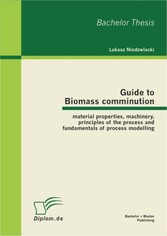Suchen und Finden
Mehr zum Inhalt

Guide to Biomass comminution: material properties, machinery, principles of the process and fundamentals of process modelling
Textprobe: Kapitel 1.3, Structure of biomass - wood as an example: Biomass has a composite structure. It consists of fibres which are made of cellulose and matrix that binds fibres together. Matrix consists of hemicelluloses and in case of ligno-cellulosic (woody) biomass also lignin. Biomass is highly anisotropic material which means that it has different properties, strongly depending on coordinates - namely fibre (cell wall) direction. The most important thing about wood that should be understood is a basic fact that it has evolved for millions of years to serve three main functions in a plant as an organism (U.S. Forest Products Labolatory, 2010): - conduction of water and nutrients from the roots to the leaves. - mechanical support of the plant body. - storage of bio-chemicals. 'There is no property of wood, no matter physical, mechanical, chemical, biological or technological - that is not fundamentally derived from the fact that wood is formed to meet the needs of the living tree. By understanding the function of wood in the living tree, we can better understand the strengths and limitation it presents.' (U.S. Forest Products Labolatory, 2010). In most of the cases wood is used as a material in terms of trees, when stumps and leaves are usually not utilised. In Bioenergy segment this statement is also true and in case of herbaceous biomass stalk is the main part being used (straw) and although it looks little bit different it's designed by nature to meet the similar needs. Properties concerning comminution of woody biomass are to some extend true also for other types of biomass as well as other fibrous materials which are mostly of biomass origin. Trunk of the tree (stem) is composed of various materials present in the concentric bands (U.S. Forest Products Labolatory, 2010): - Outer bark (Fig. 1.2 - ob) provides mechanical protection of the softer inner bark and also helps to limit evaporative water loss. - Inner bark (Fig. 1.2 - ib) it's the tissue through which sugars (food) produced by photosynthesis are translocated from the leaves to the roots or growing parts of the tree. Minerals and nutrients are also transported from the roots to the green parts. - Vascular cambium (Fig. 1.2 - vc) is the layer between bark and the wood that produces both of these tissues each year. - Sapwood the active tissue which is responsible not only conduction of sap and water but also for storage and synthesis of photosynthate like starch and lipids. - Heartwood is a darker-coloured wood in the middle of most trees. It's not conductive and functions as a long term storage of biochemicals (extractives). Extractives are formed by parenchyma cells at the heartwood-sapwood boundary and then exuded through pits into adjacent cells (U.S. Forest Products Labolatory, 2010). - Pitch (Fig. 1.6 - p) is located at the very centre of the trunk and is the remnant of early growth of the trunk before it was formed.Figure 1.2 - Macroscopic view of a transverse section of a trunk (U.S. Forest Products Labolatory, 2010).
Alle Preise verstehen sich inklusive der gesetzlichen MwSt.







